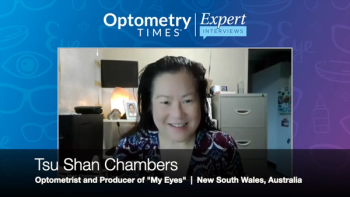
- December digital edition 2020
- Volume 12
- Issue 12
Long-term follow-up of angiod streaks
Angioid streaks are due to Bruch membrane disintegration, not elastic deterioration
Nearly 2 and-half decades ago, we reported a case of angioid streaks which were determined to be secondary to iron deposition at the level of Bruch membrane. The underlying systemic condition responsible for this was AC hemoglobinopathy, a rare blood dyscrasia related to thallasemia and sickle-cell disease.1
In that publication, the clinical picture of angioid streaks was not that of the classical branching pattern, nor was the cause related to an elastic-tissue disorder, most prevalently pseudoxanthoma elasticum as classically described (think the PEPSI-trauma mnemonic: Pseudoxanthoma Elasticum, Paget’s disease of bone, Sickle cell anemia or other hemoglobinopathy [Thalassemias], Idiopathic).2-5 The patient was followed closely over many years during which the clinical picture evolved to the complication of choroidal neovascularization (CNV).
Following the case
Figure 1 is the presentation when the patient reported distorted vision and attended for an unscheduled visit. Visual acuity in the right eye was 20/80, and fluorescein angiography demonstrated occult CNV involving the macula (Figure 2). The patient was treated with photodynamic therapy, which was the standard for CNV due to age-related macular degeneration (AMD) at the time. On follow-up at 1 year, visual acuity stabilized at 20/80, and the right fundus is depicted in Figure 3. Eventually, the natural course of CNV evolved, and the right eye is shown in Figure 4.
The patient was monitored for changes in the fellow eye which did not show evidence of macular complications until 3 years later. The patient again reported disturbed vision involving the left eye (Figure 5). Visual acuity was 20/40. The prominent treatment for CNV at this point was intravitreal injection of anti-vascular endothelial growth factor (VEGF) agents. The patient was treated at this point. At 1 year post-op, visual acuity was 20/40 (Figure 6). He maintained 20/40 visual acuity for the next 5 years at which time he was scheduled for cataract surgery (Figure 7).
This case illustrates the long-term follow-up of a patient who developed CNV secondary to an unusual presentation of angioid streaks. The mechanism for angioid streaks here is due to Bruch membrane becoming brittle, as opposed to elastic deterioration as is more common with other etiologies of angioid streaks.
The other point that can be gleaned from this case is the improvement of treatment for CNV. Photodynamic therapy was a revolution over laser treatment. The aim of this treatment was to maintain the baseline visual acuity. With the advent of anti-VEGF treatments, patient outcomes were improved to the point of improving visual acuity due to CNV. This has now become useful treatment methodologies for CNV due to a variety of etiologies.5
References
1. McBrayer GM, Semes L, Stephens GG. Angioid streaks and AC hemoglobinopathy--a newly discovered association. J Am Optom Assoc. 1993 Apr;64(4):250-3.
2. Agrawal R, Rosar AP, Lavric A. Multiple Choroidal Ruptures in a Patient With Angioid Streaks. JAMA Ophthalmol. 2017 Mar 9;135(3):e165466.
3. Johnson BW, Oshinskie L. Diagnosis and management of angioid streaks. J Am Optom Assoc. 1988;59(9):704-711.
4. Gurwood AS, Mastrangelo DL. Understanding angioid streaks. J Am Optom Assoc. 1997 May;68(5):309-24. Erratum in: J Am Optom Assoc 1997 Jul;68(7):406.
5. Chatziralli I, Saitakis G, Dimitriou E, Chatzirallis A, Stoungioti S, Theodossiadis G, Theodossiadis P. Angiod Streaks: A Comprehensive Review From Pathophysiology to Treatment. Retina. 2019 Jan;39(1):1-11.
Articles in this issue
about 5 years ago
New ways to keep dry eye patients comfortable in contact lensesabout 5 years ago
ODs look back on 2020about 5 years ago
Cataract surgery 2020 updateabout 5 years ago
Can AI rescue physicians from EHR woes?about 5 years ago
How to handle dry eye follow-up visitsabout 5 years ago
Quiz: Know the ocular effects of eyelash growth serumsabout 5 years ago
Know the ocular effects of eyelash growth serumsabout 5 years ago
Quiz answers: Know the ocular effects of eyelash growth serumsabout 5 years ago
How to manage orbital fracturesabout 5 years ago
Navigate postop IOP control with wound burpingNewsletter
Want more insights like this? Subscribe to Optometry Times and get clinical pearls and practice tips delivered straight to your inbox.













































.png)


